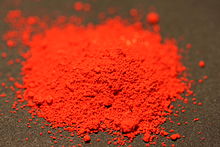Cadmium selenide
| Crystal structure | |||||||||||||||||||
|---|---|---|---|---|---|---|---|---|---|---|---|---|---|---|---|---|---|---|---|

|
|||||||||||||||||||
| __ Cd 2+ __ Se 2− | |||||||||||||||||||
| General | |||||||||||||||||||
| Surname | Cadmium selenide | ||||||||||||||||||
| other names |
|
||||||||||||||||||
| Ratio formula | CdSe | ||||||||||||||||||
| Brief description |
white to brown solid |
||||||||||||||||||
| External identifiers / databases | |||||||||||||||||||
|
|||||||||||||||||||
| properties | |||||||||||||||||||
| Molar mass | 191.36 g mol −1 | ||||||||||||||||||
| Physical state |
firmly |
||||||||||||||||||
| density |
5.81 g cm −3 (25 ° C) |
||||||||||||||||||
| Melting point |
> 1350 ° C |
||||||||||||||||||
| solubility |
almost insoluble in water |
||||||||||||||||||
| safety instructions | |||||||||||||||||||
|
|||||||||||||||||||
| MAK |
repealed as carcinogenic |
||||||||||||||||||
| As far as possible and customary, SI units are used. Unless otherwise noted, the data given apply to standard conditions . | |||||||||||||||||||
Cadmium selenide , CdSe , is the cadmium salt of hydrogen selenide . The red solid crystallizes in a hexagonal wurtzite structure , under high pressure a metastable form with a sodium chloride structure is also known. The compound is also known as cadmium red because of its use as a red pigment . Cadmium selenide is a semiconductor , more precisely a II-VI compound semiconductor . Due to the toxicity of the compound, it is rarely used as a semiconductor material in electronics. Cadmium selenide is transparent to infrared light, which is why it is occasionally used as a window material in IR applications. Cadmium selenide has the maximum sensitivity at a wavelength of 730 nm.
In nature, cadmium selenide is found as a very rare mineral, cadmoselite .
Nanocrystals
In research, nanoparticles made from cadmium selenide are the focus of many research groups. Cadmium selenide is one of the most studied systems made from nanocrystals. Cadmium selenide nanocrystals can be produced in macroscopic quantities with very little size dispersion.
The three-dimensional spatial limitation of the charge carriers leads to a discretization of the electronic energy levels, which is referred to as the size quantization effect. Such quasi zero-dimensional solid-state structures are called quantum dots . The special thing about these nanocrystals is that in these dimensions the size of the crystal and not the physical composition determines the band gap energy of this semiconductor. Even a small change in size from 10 to 100 Å changes the energy difference in such a way that UV-induced fluorescence shifts the wavelength of the emitted light from blue to red. The smaller the particle, the smaller the emitted wavelength. These size quantization effects occur particularly strongly because these dimensions are below the size of a bound electron-hole pair ( exciton ).
However, with these dimensions, there are additional effects on the surface of the crystal, since around a third of the atoms are already on the surface and therefore no longer in a regular lattice structure. If you grow other semiconductors on the surface, surface imperfections can be manipulated in a targeted manner. This allows z. B. increase the quantum yield and improve the photostability. By stabilizer molecules, such as. B. TOPO , these nanocrystals can also be adapted to different (polar and non-polar) solvents.
In particular, the fluorescent color, which can be adjusted via the particle size, makes cadmium selenide nanoparticles look very promising for a number of applications, such as as biomarkers for in vitro applications or as light converters in solar cells.
Applications
Cadmium red is still used in artist paints despite significant toxicological and environmental concerns. Because of its brown-black color, pure cadmium red has no meaning as a pigment. In practice, it is mixed with cadmium sulfide (cadmium yellow). As the proportion of cadmium selenide increases, the pigment mixture changes its color from orange to red to dark red. In terms of manufacturing, it was first produced in 1910 and was able to replace the less stable cinnabarite (cinnabar), i.e. mercury sulfide , which it surpasses in color purity.
Other applications included the use as dye component for tattoos or as a brightness-sensitive coating in electrical photo resistors , to this under the RoHS Directive banned commercially. In June 1991 the EC Directive 91/338 / EEC was passed, which provides for a cadmium ban for stabilizers, pigments and galvanic coatings for certain applications.
See also
Individual evidence
- ↑ a b c d e f g Entry on cadmium selenide in the GESTIS substance database of the IFA , accessed on February 1, 2016(JavaScript required) .
- ↑ Not explicitly listed in Regulation (EC) No. 1272/2008 (CLP) , but with the specified labeling it falls under the group entries on cadmium compounds, with the exception of cadmium sulphoselenide (xCdS.yCdSe), reaction mass of cadmium sulphide with zinc sulphide (xCdS.yZnS), reaction mass of cadmium sulphide with mercury sulphide (xCdS.yHgS), and those specified elsewhere in this Annex and selenium compounds with the exception of cadmium sulphoselenide and those specified in this Annex in the Classification and Labeling Inventory of elsewhere European Chemicals Agency (ECHA), accessed on March 18, 2017. Manufacturers or distributors can expand the harmonized classification and labeling .
- ↑ Duck-Tae Kim et al .: Composition and temperature dependence of band gap and lattice constants of Mgx Cd1-x Se single crystals . In: physica status solidi, 2006, 3, 8, pp. 2665–2668. doi : 10.1002 / pssc.200669624
- ↑ Handbook of Minerals - Cadmoselite (English, PDF 56.6 kB)
- ↑ Quantum-Dot Leap - Tapping tiny crystals' inexplicable light-harvesting talent. , In: Science News , 169 (22) / 2006, p. 344.
- ↑ a b c 21010 - 21540 Cadmium colors. (No longer available online.) Kremer Pigmente GmbH & Co. KG, archived from the original on October 19, 2014 ; accessed in 2010 . Info: The archive link was inserted automatically and has not yet been checked. Please check the original and archive link according to the instructions and then remove this notice.
- ↑ Doctors newspaper: Ötzi and the history of the tattoo



